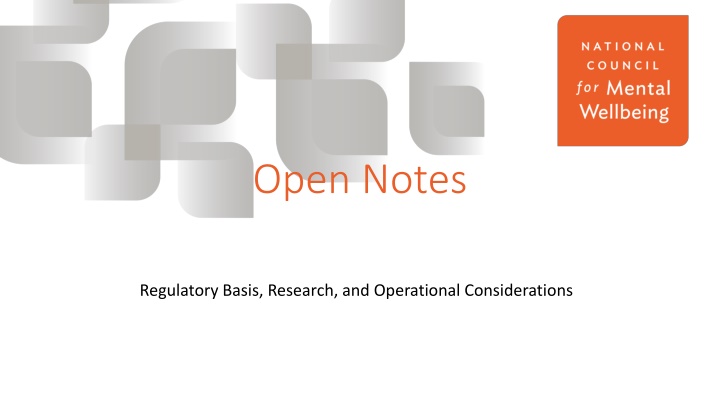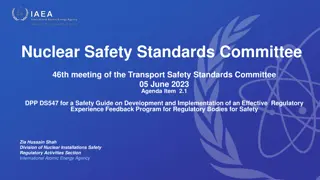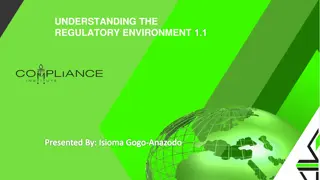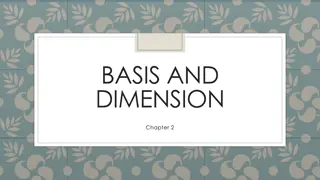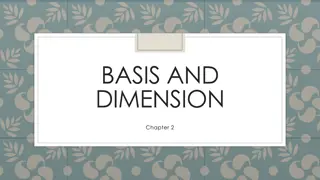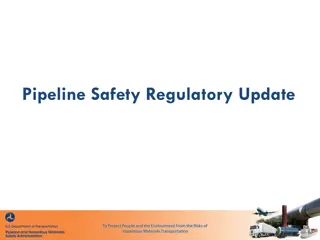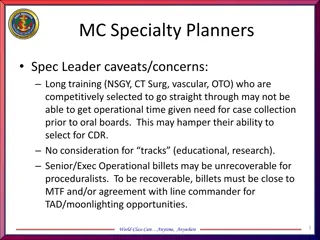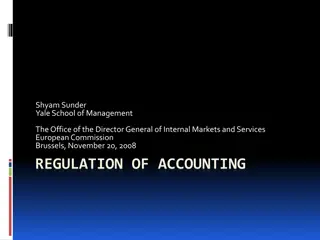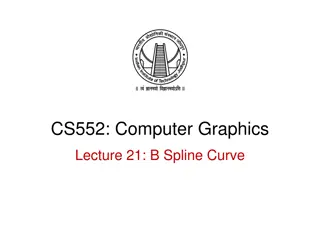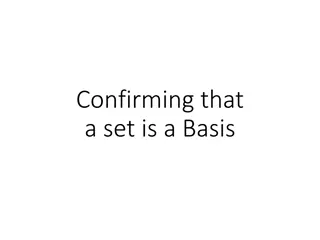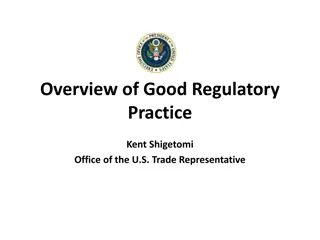Open Notes Regulatory Basis and Operational Considerations
This informational content discusses the regulatory push by CMS and ONC towards data sharing in healthcare systems, emphasizing the shift towards a more patient-centric approach through enhanced data interoperability. It highlights the goals, rules, and important dates associated with the new interoperability regulations, focusing on promoting better patient care and empowering individuals through improved data access.
Download Presentation

Please find below an Image/Link to download the presentation.
The content on the website is provided AS IS for your information and personal use only. It may not be sold, licensed, or shared on other websites without obtaining consent from the author.If you encounter any issues during the download, it is possible that the publisher has removed the file from their server.
You are allowed to download the files provided on this website for personal or commercial use, subject to the condition that they are used lawfully. All files are the property of their respective owners.
The content on the website is provided AS IS for your information and personal use only. It may not be sold, licensed, or shared on other websites without obtaining consent from the author.
E N D
Presentation Transcript
Open Notes Regulatory Basis, Research, and Operational Considerations
Disclaimer None of the information presented should be construed or relied upon as legal advice.
Overall goals of the new Interoperability rules This is a regulatory push by CMS and ONC that aims to shift the way the healthcare system shares data, moving from a system where healthcare organizations may share data under HIPAA to one where they must share data Data moves with patient from provider to provider, and from health plan to health plan Patient data is made available through mobile and web-based apps Freer flow of data empowers patients and helps improve value-based care efforts March 2020 3
The ONC and CMS rules apply to. Providers Make Patient health information (EHI) available through Application Programming Interfaces (APIs) Provide electronic notification to other providers when a patient is admitted, discharged or transferred (ADT) Information blocking prohibited Payers Patient claim /health data (EHI) made available through APIs Patient data shared with other payers as they move from health plan to health plan HIT Developers Use APIs New Certification requirements Third-Party Apps Use APIs Transition from use of CCDA to the new USCDI Provider Vendors Third-Party Apps Insurers *EHI (final rule) is defined as ePHI to the extent that it would be included in a designated record set. March 2020 4
Important Dates April 5, 2021 - Information blocking prohibited Electronic health information (EHI) definition is limited to only information defined in United States Core Data for Interoperability (USCDI) standards USCDI standards expanded to include progress notes Only data in USCDI standards must meet interoperability requirements on HIEs May 1, 2021 ADT Notifications Required October 6, 2022 EHI definition is expanded beyond defined elements in USCDI to include any information that an organization has that is: (i) Transmitted by electronic media; (ii) Maintained in electronic media; or The above definition includes information and other provider impaired data systems beyond the EMR alone December 31, 2021 Providers and payers required to have full export capability for all their EHI
What data needs to be shared? Within the first 24 months expands to HIPAA data set after 24 months Allergies and intolerances Assessment and Plan of Treatment Care Team Members Goals Health Concerns Immunizations Laboratory Medications Patient Demographics Problems Procedures Provenance Smoking Status Unique Device Identifier(s) Vital Signs Clinical Notes* Consult Note Discharge Summary H&P Imaging Narrative Pathology Narrative Procedure Progress Note Standards: https://www.healthit.gov/isa/united-states-core- data-interoperability-uscdi * Currently not part of Netsmart CCD Standard
Scope of ONC Rule ONC Rule covers two main areas: Information Blocking and HIT Certification Criteria Information Blocking Information Blocking Exceptions Information Blocking Information Blocking Preventing Harm A practice by a healthcare provider, HIT developer, or HIE/HIN that, except as required by law or specified by the Secretary as a reasonable and necessary activity, is likely to interfere with, prevent, or materially discourage access, exchange or use of EHI. Privacy Exception Security Exception Infeasibility Exception HIT Performance Exception Content and Manner Exception Fees Exception Licensing Exception March 2020 7
More on Exceptions EHRs with the capability to give patients direct and immediate access will generally need to provide instant access. If you keep EHI but do not have an EHR that allows for direct and immediate patient access will likely come under the infeasibility exception to the instant access requirement. May exclude notes of any type that may cause harm to the patient or others should the patient have access. However, the rule specifically states that psychological distress does not meet the definition of harm (Torous, 2020). Substantial Harm meaning life threatening or physical harm. To exercise the privacy exemption the patients request to not share EHI must be documented in the record
Psychotherapy Note Exception Psychotherapy notes are exempt from the information blocking prohibition Psychotherapy Notes Are Not Any documentation information required for billing History, symptoms, mental status exam, therapist interventions Psychotherapy Notes Are Documentation about the therapist s emotional reactions, fantasies, and internal associations that occur in relation to the patient i.e. Traditional psychoanalytic process notes To be exempt from information blocking psychotherapy notes must be kept entirely separate from the rest of the patient record Uncertified EHRs such as PsyBooks are not required to follow the Open Notes Rule
Psychotherapy with content that is considered medical record notes cannot be blocked. Diagnosis Symptoms Functional status Treatment plans Prognosis Progress to date Session start and stop times Test results The modalities and frequencies of treatment furnished Medication prescription and monitoring
IT Considerations EMR Vendors are required to have their EMR capable of meeting the ONC requirements in order to be ONC/CMS certified which is a requirement for submitting billing to CMS The EMR internal capability to extract and export patient information is likely to be implemented as part of a regular EMR update without additional cost The ability to provide access to the exported data via a patient portal or connection to an HIE is usually a functional module that must be purchase/subscribe to separately from the basic EMR package The information blocking exception for privacy requires specific documentation that the patient has requested that their information not be shared. Uniformly encouraging patients to exercise this is considered information blocking. There are currently no penalties for providers not complying with the interoperability requirements. CMS has stated that disincentives for noncompliance will be implemented in the future
OpenNotes (aka Concurrent Documentation) Research In 2010, Beth Israel Deaconess, Geisinger Health System, and Seattle's Harborview Medical Center did a study involving 105 primary care doctors with 20,000 of their patients able to read their clinical notes via secure online patient portals. Doctors reported little change in workload and clinician fears were unfounded. Patients overwhelmingly approved of note sharing; few were worried or confused by their notes. patients reported that reading notes helped them feel more in control of their health and health care. 25% reported finding errors- most commonly diagnosis, history and medication OpenNotes in Mental Health VA study - patient experiences are more positive than negative when reading mental health notes Beth Israel Deaconess Medical Center study 94% agreed that having open therapy notes is a good idea and 87% wanted it to continue. More than half reported therapy notes were 'very important'... for feeling in control of their care, trusting their providers and taking care of themselves. Two felt offended, and 7 (11%) felt judged by something they read in a note.
Collaborative Documentation Collaborative documentation is a practice where clinician and patient document together, during the session. Collaborative documentation = (Concurrent Documentation + Shared Decision-Making) Advantages Reduces errors and misunderstandings Enhances patient engagement and empowerment Documentation is always completed on time by the end of the session Patients are never surprised when they read the note X Patient centered Training available Through MTM and the National Council
Implementation to Do List Contact your EMR vendor find out the details of how they will be implementing the interoperability requirements Review and Revise Policies forms and procedures for: Providing information to patients and other healthcare providers Requesting information from other healthcare providers including ADT from hospitals Documenting privacy exemption to information blocking Review and Revise Patient education materials Staff training program Policies and procedures listed above Open notes and/or collaborative documentation
